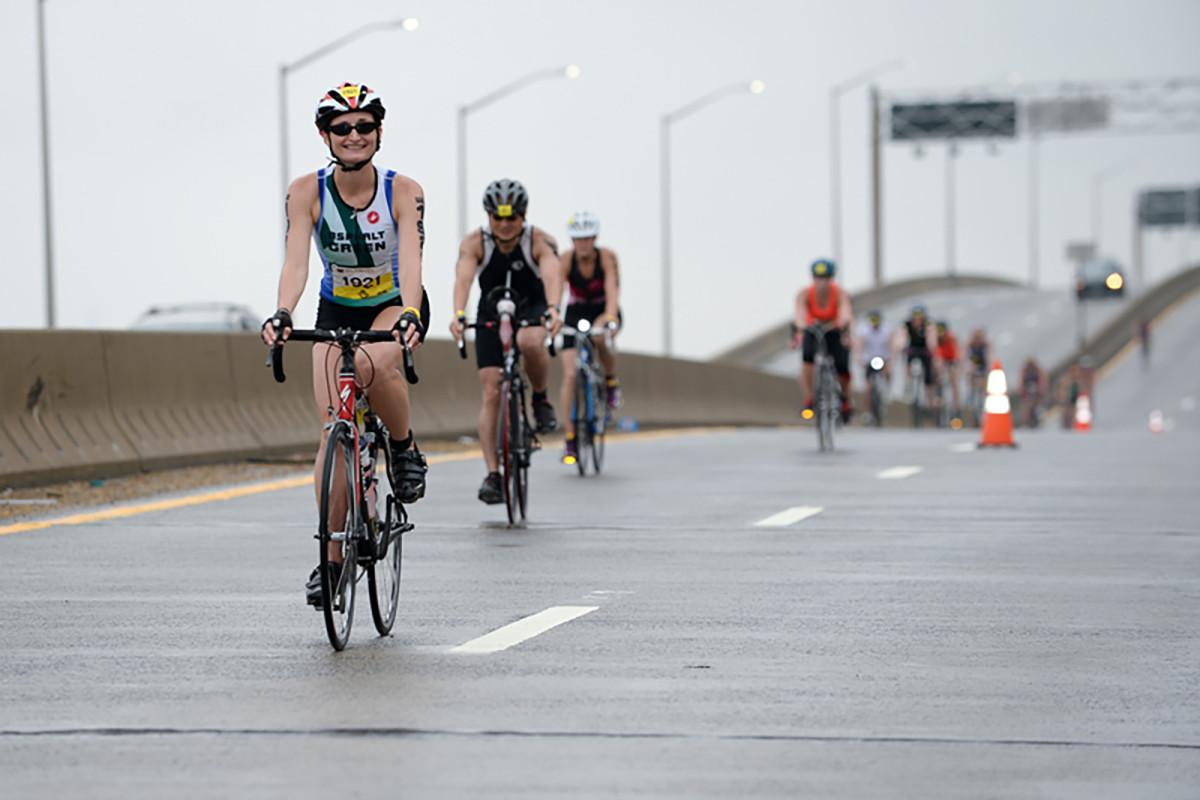How to conquer the biggest challenges first-time triathletes face on race day

So, you took the plunge and signed up for your first triathlon. Now, you’re left trying to figure out not only how you should train to ensure that you make it to the finish line, but also trying to figure out some of the nuances of the race itself. When it comes to a triathlon, the race isn’t quite as simple as just swimming, biking and running.
According to Alex Isaly, a lead trainer for LifeTime Fitness and a seasoned triathlete himself, a handful of things can overwhelm the first-time triathlete, including the mass swim start and the transitions—both things that are incredibly difficult to practice outside of the race environment.
Taking on the triathlon: A first-timer's quest to complete the swim, bike, run
Here are a few key things for newbie triathletes (myself included) to keep in mind during the training process and on race day.
Don’t overtrain
Many triathletes look at the overall distance of the race and think about the time that he or she will be in motion—for me, I imagine about three-and-a-half hours will elapse from the time that I jump into the Hudson River to the time that I cross the finish line. But I’m not going to try and replicate the entire race, or even do a workout that equals the approximate time the race will take me.
“For someone who’s relatively new to the sport, I think as long as they train smart, they have a good program, they don’t overtrain leading up for the race and set themselves up for success, I think that’s the key,” says Isaly.
The best sport swimsuits for laps, surfing, snorkeling and more
As previously mentioned, I’m aiming to complete three run workouts, three bike workouts and one swim workout a week. My workouts will give me an opportunity to learn how to properly hydrate and fuel myself, and allow me to push my body when it’s tired, while also factoring in recovery days with either yoga or pilates, or complete rest. Sure, I’m allowing plenty of unknowns to factor into my race day, but that’s part of the experience.
In addition, Isaly recommends tapering down the workouts in the final week before the race to ensure that your body is fully rested—but not so much that your body becomes lazy. He suggests shorter, high-intensity interval training workouts to get the heart rate up and the blood flowing and keep muscles flexible. For example, a run workout might be a series of 30-second sprints, followed by a two- or three-minute recovery, repeated a number of times.
Stay calm during the mass swim start
According to Isaly, the No. 1 thing that can be most overwhelming for new triathletes can be the mass swim start. Each triathlon (with an open-water swim leg, of course) differs slightly, but the concept is mostly the same: when the starting gun goes off, lots of hyped-up athletes leap into the water, creating a frenzy of bodies. You might not realize it, but yes, triathlon can be a contact sport.
“You’ve got people that are swimming over you, under you, they’re grabbing your legs, they’re grabbing your head, they’re pulling your goggles off—it can be very intimidating,” Isaly says. “I always tell new triathletes to expect it but stay calm. It’s for a very short period of time—once you can get through the first 100 meters of the swim, the chaos will go away.”
If a triathlete is concerned about getting caught up in the chaos, Isaly recommends either starting in the back of your group and allowing the more aggressive swimmers off the line first or starting out on the edge of the swim course, where it’s often less crowded. Sure, there’s a chance you’ll lose a few seconds off the start or you might swim a few extra meters, but it’s worth it if you’re able to maintain your sanity.
Find your point direction during the swim
In an open-water swim leg, there aren’t lane lines helping you swim in a straight line, so it’s crucial for each athlete to find a marker—whether it’s a buoy or a specific point in the distance—to help him or her stay swimming in the right direction and remain efficient, instead of zig-zagging back and forth.
“For a river swim, it’s a little easier to go straight. You can use the riverbank to make sure of your distance. There’s probably going to be buoys along the swim—some triathletes like to stay right on the buoy line because it makes it easier—but find your line and your point of direction, and pop your head up every now and then to take a look and make sure you’re in line,” Isaly recommends.

Don’t rush through transitions
The transitions of a triathlon race—shifting from the swim to the bike or the bike to the run in a designated area—can often be the hardest part of a triathlon for first-timers. Not only can the designated area be incredibly hectic, with athletes rushing about, trying to swap out gear, but it’s also very hard to mimic that environment outside of a race, making it difficult for newbies to prepare for.
So the most important thing? Make sure you organize your station before the start of the race and don’t panic throughout the entire process of shifting sports.
“The key for the transition area is to make sure that you have it all set up the right way,” Isaly says. “You want to make sure you have everything you need for the bike in one area, and then when you come back to drop the bike, you have your running shoes, a hat and sunglasses right there besides your cycle stuff.”
How extended breaks in training help elite athletes—and why you should take them too
Additionally, Isaly mentions that one of the biggest mistakes a triathlete can make is coming out of the transition area full-throttle. Instead, athletes should aim to allow their body to transition sports at a gradual pace, eventually working up to full capacity.
“From a physiological standpoint, your body has just swam 1500 meters, and now you’re going to get on the bike. The swim was mostly upper body, and now you’ve got to get on the bike and transition from swimming to now all legs. Use the first few 100 meters or the first half-mile of the bike, just get into a nice groove. Control your breathing, let your body adapt to working a different way. Once you feel like you can make the transition into riding harder, than you increase the intensity. Just stay calm, cool and collected,” Isaly says.
Embrace the event
Like many athletic events, there are so many factors that can impact how you perform on race day—from the weather or getting a flat tire on the bike to waking up and feeling sluggish or nervous. Ultimately, rolling with the punches (and the tired legs) will keep you happy all the way to the finish line.
“I tell the athletes that I train is as long as you can show up on race day and feel like you gave 100%, and walked away from it making it a great experience, regardless of what happens, whether you set a PR or you get a flat on the bike, it just comes with the race, I think that’s key for embracing it and having a great event and a great experience.”
